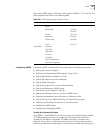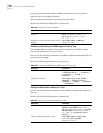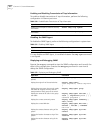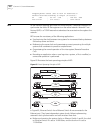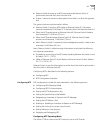
274 CHAPTER 11: SYSTEM MANAGEMENT
5 Set the administrator ID, contact and the physical location of the Ethernet switch.
[SW7750]snmp-agent sys-info contact Mr.Smith-Tel:3306
[SW7750]snmp-agent sys-info location telephone-closet,3rd-floor
6 Enable the SNMP agent to send the trap to Network Management Station whose
IP address is 129.102.149.23. The SNMP community is public.
[SW7750]snmp-agent trap enable standard authentication
[SW7750]snmp-agent trap enable standard coldstart
[SW7750]snmp-agent trap enable standard linkup
[SW7750]snmp-agent trap enable standard linkdown
[SW7750]snmp-agent target-host trap address udp-domain
129.102.149.23 udp-port 5000 params securityname public
RMON Remote Network Monitoring (RMON) is a type of IETF-defined MIB. It is the most
important enhancement to the MIB II standard. It is used for monitoring the data
traffic on a segment and even on a whole network. It is one of the most widely
used network management standards.
RMON is based on the SNMP architecture and is compatible with the existing
SNMP framework, so it is not necessary to adjust the protocol. RMON includes
NMS and the agent running on the network devices. On the network monitor or
detector, RMON agent tracks and accounts for different traffic information on the
segment connected to its port. For example, the total number of packets on a
segment in a certain period of time or that of the correct packets sent to a host.
RMON helps the SNMP monitor the remote network device more actively and
effectively, which provides a highly efficient means for monitoring subnet
operations. RMON can reduce communication traffic between the NMS and the
agent, thus facilitating an effective management over large interconnected
networks.
RMON allows multiple monitors. It can collect data in two ways.
1 The first way is with a special RMON probe. NMS directly obtains the management
information from the RMON probe and controls the network resource. In this way,
it obtains all the information of RMON MIB.
2 The second way is to implant the RMON Agent directly into the network devices,
such as routers, switches, hubs, and so on, so that the devices become network
facilities with RMON probe functions. RMON NMS uses the basic SNMP
commands to exchange data information with the SNMP Agent and to collect NM
information. However, not all the data of the RMON MIB can be obtained with this
method, depending on resources. In most cases, only four groups of information
can be collected. The four groups are: trap information, event information, history
information and statistics information.
The Switch 7750 implements RMON using the second method. With the
RMON-supported SNMP agent running on the network monitor, NMS can obtain
such information as the overall traffic of the segment connected to the managed
network device port, the error statistics and performance statistics, thereby
implementing the management (usually remote) over the network.
Configuring RMON RMON configuration includes tasks described in the following sections:




